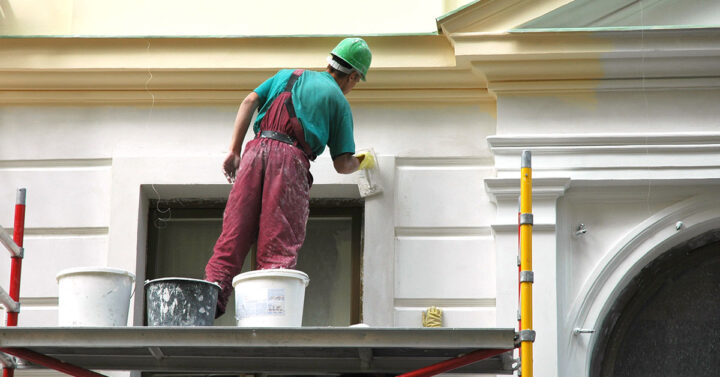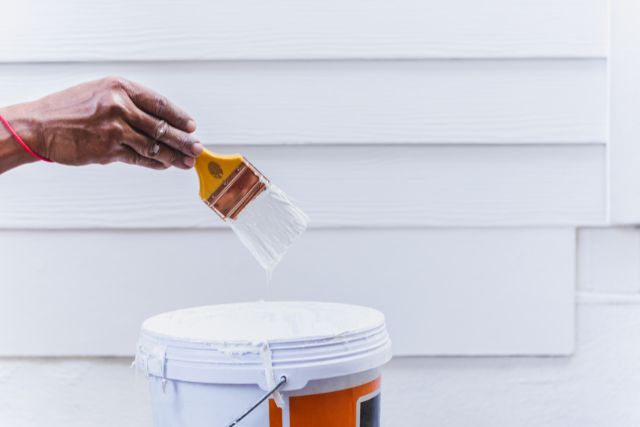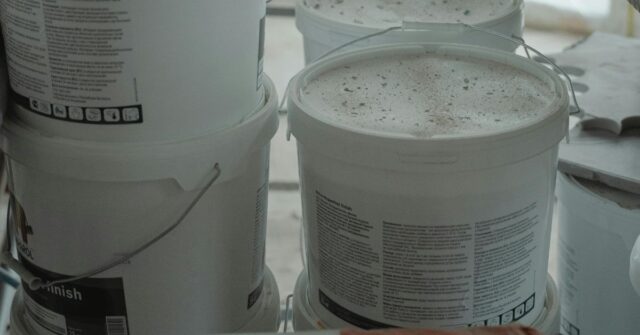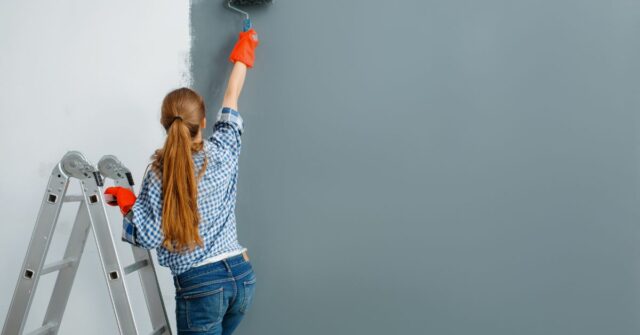Have you ever found yourself with leftover exterior paint and thought, “Why not use it on a wall indoors?” You’re not alone.
Many DIYers and homeowners wonder if it’s okay – or even smart – to use exterior paint inside the house.
While it might seem like a practical solution, the truth is a bit more complicated. Let’s dig into the facts, the science, and the expert advice that’ll help you decide what really belongs on your interior walls.
Understanding the Key Differences Between Interior and Exterior Paint
At first glance, paint is just paint, right? Not quite. The type of paint you choose can make or break your project, both in terms of looks and longevity.
More importantly, it can impact your health and comfort inside the home.


What Is Interior Paint Designed For?
Interior paint is built to live inside – literally. It’s made to handle things like scuffs, scrubbing, and the constant exposure to indoor air.
Unlike exterior paint, it doesn’t need to fight off rain, UV rays, or drastic temperature changes.
What it needs to do is dry without strong odours, be easy to clean, and resist fading in artificial lighting.
What Makes Exterior Paint Unique?
Exterior paint is the tough guy of the paint family. It’s engineered to withstand wild weather, harsh sun, and even mildew.
That means it contains additives and chemicals that interior paint doesn’t. These extras help it flex with temperature changes and bond strongly to outdoor surfaces like brick, timber, and render.
But they also make it less friendly to indoor environments.
Chemical Composition and Additives Compared
Here’s where things get serious. Exterior paints usually contain more volatile organic compounds (VOCs) and fungicides.
VOCs help the paint dry more slowly and tougher, perfect for outdoor conditions.
But inside? Those same VOCs hang in the air longer and can cause headaches, dizziness, and even respiratory problems with extended exposure. It’s a classic case of “right tool, wrong job.”


Is It Safe to Use Exterior Paint Indoors?
Short answer: not really. Long answer: it depends on the type, the ventilation, and how sensitive the people in the home are to chemicals. But most experts agree – it’s a risky move.
The Role of Volatile Organic Compounds (VOCs)
VOCs are chemicals that evaporate into the air as the paint dries. In well-ventilated outdoor spaces, they disperse quickly.
Indoors? Not so much. These compounds linger, especially in poorly ventilated rooms like bathrooms or basements.
And prolonged exposure can lead to eye irritation, breathing issues, and in extreme cases, long-term health effects.
Health Risks Associated with Indoor Use
Kids, pets, and people with asthma or allergies are especially vulnerable. Even after the paint “dries,” it can continue to release fumes for weeks – or longer.
Some exterior paints even contain biocides to prevent mould, which aren’t intended for use in closed spaces. Breathing those in regularly is far from ideal, to say the least.
Impact on Indoor Air Quality Over Time
Paint doesn’t just sit there – it interacts with your environment. Using exterior paint inside can steadily degrade air quality.
Unlike interior paint, which is formulated to stop off-gassing once dry, exterior paint can keep emitting VOCs over time, especially in high-heat or humid rooms. It’s not just about smell – it’s about safety.


Performance of Exterior Paint on Indoor Surfaces
Let’s say you’ve weighed the risks and still want to try it. How will it actually perform indoors? That’s another can of worms.
Adhesion and Finish Results
Exterior paint is stickier and thicker than interior paint. It’s built to cling to rough, porous outdoor surfaces.
On indoor plaster or drywall, it might go on unevenly, feel rubbery, or dry with a sheen that looks out of place. Worse, it might peel or crack over time, especially if the wall flexes or gets bumped.
Durability and Wear Inside the Home
Ironically, exterior paint isn’t always more durable indoors. It can scuff more easily, attract dust, or react poorly with cleaning products.
Plus, because it doesn’t cure the same way indoors, it might stay soft longer, leaving your walls more vulnerable to fingerprints and furniture scrapes.
Compatibility With Common Interior Materials
Materials like plasterboard, timber trims, or skirting boards are treated differently from exteriors.
Exterior paint may not bond well with certain sealants or undercoats used inside, leading to bubbling or chalking. That means more work – and more money – fixing the damage down the track.


Cost Considerations and Practicality
Let’s face it – one of the main reasons people consider using exterior paint indoors is to save money. But does it actually work out that way?
Does It Really Save Money?
Sure, you might save a few bucks by using up what you’ve got. But if that leads to poor adhesion, bad air quality, or the need to repaint, you’ll be shelling out more than you saved.
Paint is cheap compared to the cost of labour and time. Don’t cut corners just to save a few dollars upfront.
Potential Costs of Repainting or Health Issues
Interior repainting can cost hundreds – or thousands – if you need to remove or seal off problem paint.
Add in potential health costs from prolonged exposure to chemicals, and suddenly, that “free” bucket of paint isn’t so free. The safest option often ends up being the most cost-effective in the long run.
When, If Ever, Can Exterior Paint Be Used Indoors?
It’s not always a hard “no,” but you’d need a good reason – and the right conditions – to justify it. And even then, there are caveats.
Rare Exceptions and Controlled Conditions
In places like sheds, garages, or semi-outdoor areas with excellent airflow, exterior paint might be okay.
These are not living areas, and ventilation can prevent most of the issues we’ve talked about. But even then, it’s best to choose a paint labelled as safe for both interior and exterior use.


Low-VOC and Dual-Purpose Paints
Some newer paint products are rated for both inside and out. These formulas contain lower VOCs and are safer in indoor environments.
Always read the label and look for certifications from Australian standards authorities to be confident in their safety claims.
Professional Recommendations for Special Cases
Painters sometimes use exterior primers or sealants indoors for stubborn stains or water-damaged surfaces.
But these are applied under strict conditions, followed by low-VOC topcoats. If you’re unsure, it’s best to get advice from someone with real experience before experimenting with your home’s air quality.
Best Practices for Choosing the Right Paint
Now that we’ve ruled out most indoor uses for exterior paint, what should you use instead? Here’s how to pick the right product the first time.
Factors to Consider Before Buying
Think about the room’s function. Is it a bedroom, kitchen, or wet area? Different paints serve different needs.
Look for labels that match the space – moisture-resistant for bathrooms, low-sheen for kids’ rooms, and washable finishes for high-traffic areas.


Environmentally Friendly and Safe Paint Options
Look for Australian-certified low-VOC or no-VOC paints. Many brands now offer paints that are safer for your family and the environment.
These options dry faster, smell less, and don’t compromise indoor air quality.
Why Paint Type Matters for Each Room
You wouldn’t wear hiking boots to the beach, right? Similarly, each room in your home needs the right type of paint.
Kitchens need resistance to grease and scrubbing. Bedrooms benefit from low-odour paints. And ceilings? They require something that hides imperfections while resisting flaking.
Conclusion: Expert Advice From Professional Painters
So, can you use exterior paint inside? Technically, yes – but it’s rarely a good idea.
The risks often outweigh the rewards, especially when it comes to your health and the long-term look of your home.
There’s a reason paint companies make specific formulas for different settings.


Final Verdict on Using Exterior Paint Indoors
Unless you’re painting a shed or a similar space with excellent ventilation, it’s best to keep exterior paint where it belongs – outside.
Indoor spaces require finishes that are safer, cleaner, and designed for daily life.
Safer and Smarter Alternatives
Stick with interior paints designed for your space. They’re easier to apply, better for your health, and will make your home look and feel better for years to come.
And if you’re stuck with leftover exterior paint? Seal the lid tightly and save it for the next outdoor touch-up.
When in Doubt, Ask a Professional
If you’re unsure about what type of paint to use, get advice from a licensed painter. A quick chat with someone in the know can save you hours of work and hundreds of dollars.
Your walls – and your lungs – will thank you for it.





